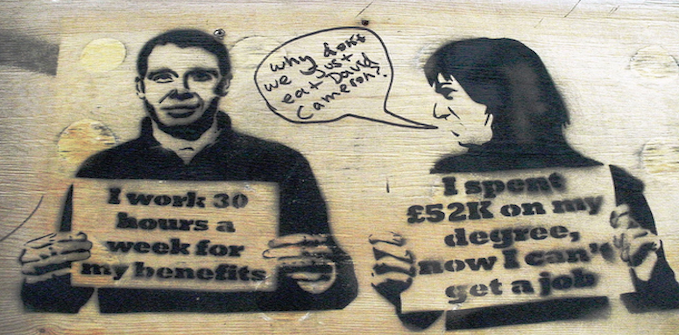In The Richer, The Poorer: How Britain Enriched the Few and Failed the Poor, Stewart Lansley explores how public policy has shaped economic inequality in Britain since the nineteenth century. Written with academic precision and a journalist’s panache, the book offers a valuable statement of a distinctively social democratic view of modern British history, with recommendations that deserve serious attention, writes Peter Sloman.
The Richer, The Poorer: How Britain Enriched the Few and Failed the Poor. Stewart Lansley. Policy Press. 2022.
Find this book (affiliate link):![]()
 The issue of economic inequality has been moving up the UK political agenda for more than a decade, ever since New Labour’s efforts to combine economic growth with incremental poverty relief were thrown off course by the 2008 financial crisis. Richard Wilkinson and Kate Pickett’s bestselling book The Spirit Level helped to reinvigorate popular discussion of the social costs of inequality, whilst Tony Atkinson’s Inequality: What Can Be Done? summarised the evidence for the US and the UK and set out a menu of options for reducing wealth and income differentials. Stewart Lansley’s new book The Richer, The Poorer is an important addition to this growing literature.
The issue of economic inequality has been moving up the UK political agenda for more than a decade, ever since New Labour’s efforts to combine economic growth with incremental poverty relief were thrown off course by the 2008 financial crisis. Richard Wilkinson and Kate Pickett’s bestselling book The Spirit Level helped to reinvigorate popular discussion of the social costs of inequality, whilst Tony Atkinson’s Inequality: What Can Be Done? summarised the evidence for the US and the UK and set out a menu of options for reducing wealth and income differentials. Stewart Lansley’s new book The Richer, The Poorer is an important addition to this growing literature.
By tracing how public policy has shaped economic inequality in Britain since the nineteenth century, Lansley provides an accessible overview of the relationship between ‘the rich’ and ‘the poor’ in modern Britain, written with both academic precision and a journalist’s panache. At the same time, the very fitting dedication – ‘to the memories of Peter Townsend, David Donnison, Tony Atkinson, John Veit-Wilson and John Hills’ – reminds us that Lansley has himself been involved in research and campaigning on poverty and inequality since the 1970s. From a historian’s perspective, The Richer, The Poorer thus serves as a valuable statement of a distinctively social democratic view of modern British history, coloured by the efforts of two generations of social policy experts to resist the regressive effects of Conservative government policies.
The basic story which frames Lansley’s narrative is one of the Kuznets curve going into reverse. On this account, Britain was brought out of the deeply unequal social relations of the late nineteenth century (‘Britain’s gilded age’) by the campaigning work of the labour movement and the equalising effects of the two World Wars, which shed a harsh light on the privileges of ‘high society’ and created a new (if somewhat fragile) sense of social obligation.
During the 1940s, ‘the distribution question’ became ‘central to the political agenda’ (63) and, after a decade of complacent affluence, the 1960s ‘rediscovery of poverty’ helped to put it back there. Under the 1974-79 Labour government, Britain reached ‘peak equality’, but efforts to achieve a further ‘shift in the balance of power and wealth’ ran into a sharp political backlash as economic growth faltered. There followed a ‘great widening’, as Margaret Thatcher’s government cut income tax, whittled back benefit rates, attacked the unions and encouraged firms (especially in the City of London) to abandon the post-war ‘culture of restraint’ in favour of ‘a much more ruthless model of capitalism’ (148). ‘Predatory and extractive corporate behaviour […] became increasingly commonplace’ (151), and New Labour lacked the political heft (or courage) to rein it in.
The UK has thus become a ‘high-poverty, high-inequality nation’ in which ‘the struggles for share’ are once again ‘won by the richest and most affluent sections of society’ (239). Though the narrative of The Richer, The Poorer starts in 1800, the period up to World War Two is dealt with very briskly, and more than half the book is devoted to the period since 1979.

Image Credit: Image by Kevin Schneider from Pixabay
In telling this story, Lansley makes two major interpretative choices which give his analysis a distinctive character. Firstly, Lansley presents the UK’s high level of material inequality largely as a result of exploitation by a narrow and self-interested elite, a phenomenon which he calls ‘extractive capitalism’. In both its nineteenth and twenty-first-century forms, extractive capitalism involves ‘an economic model that is heavily geared to enrichment of the few via mechanisms that extract an excessive share of the gains from existing corporate and financial wealth, and from the creation of new wealth, in ways which have significant economic, social and community side-effects’ (xvii).
In many respects, this focus on exploitation is a valuable one. It is certainly a salutary reminder that the extraction of wealth by ‘the few’ at the expense of broad-based growth for ‘the many’ has never been confined to authoritarian regimes, as liberal theorists such as Daron Acemoglu and James Robinson have sometimes implied. At the same time, there is a danger that focusing on ‘the super-rich’ (‘those who sit at the pinnacle of the income and wealth ladder’) and ‘the poor’ (‘those who obtain too small a share of the national cake to be able to enjoy even the most basic of contemporary living standards’ (xvi)) risks obscuring the economic fate, and political significance, of those who stand between these groups.
The implications of Lansley’s focus on extraction come through particularly clearly in his analysis of the ‘great widening’. Some scholars have seen rising inequality as a result of deep-seated socio-economic trends, such as globalisation, deindustrialisation, technological change and the rise of consumer affluence, which have reshaped social structures and political attitudes. Though Lansley acknowledges these factors, his account is essentially a top-down one, focusing on the political power of business groups and their allies in the Conservative Party. It is the economic and political elites who act as the agents of change, and then manufacture consent for inequality by persuading voters that there is no alternative.
Secondly, Lansley’s analysis of distributional trends is distinctively ‘welfarist’. If the villains of the story are Conservatives and capitalists, the heroes are mostly activists and social researchers – those men and women, from Charles Booth and Seebohm Rowntree onwards, who have called attention to the scandal of poverty amid plenty and called for the government to take action. Lansley’s deep engagement with debates over poverty measurement and social security reform comes into its own here, and he does an excellent job of setting the work of ‘poverty lobby’ groups such as the Child Poverty Action Group (CPAG) in a broader political context. If, as David Edgerton has recently suggested, social welfare was the one sphere in which post-war Labour governments could draw on a ‘left tradition of investigation and policy prescription’ distinct from that of the state, The Richer, The Poorer provides a vigorous insider’s account of how this tradition developed.
On the other hand, it is striking how gloomy social researchers were during the era which we now see as ‘peak equality’, and we might question whether the ‘poverty lobby’ has been as central to the larger story as it likes to think. In retrospect, left-wing campaigners such as Peter Townsend might have been more successful if they had been more willing to accept the degree of equalisation which had taken place between the 1940s and the 1970s, and if they had set their disagreements with Labour politicians over policies such as child benefit in the kind of broader historical perspective which Lansley adopts here.
Lansley’s concluding recommendations are ambitious but carefully judged, and deserve serious attention. He calls for a government strategy to reduce inequality, built around a ‘primary target’ of reducing the Palma ratio for incomes (that is, the ratio of the income share of the richest 10 per cent to that of the poorest 40 per cent) from 1.5 to 1.25 over a decade, along with a similar target for wealth (244). On the poverty side, an ‘initial and realistic target’ might ‘be based on the average level of poverty achieved by other comparable rich countries along with the historic lows achieved in Britain in the 1970s’ (244), monitored by ‘an independent and permanent national commission’ with both expert and lay members (245).
Achieving these goals would require a battery of measures, including major tax and benefit reforms, investment in public services, wider asset ownership, new obligations for firms and ‘a more balanced division of the cake between profits and wages’ (245). It is hard to imagine any government attempting all these changes at once, but Lansley is surely right to emphasise the scale of the policies which a substantial equalisation of wealth and incomes would require. As the UK’s cost-of-living crisis deepens and energy prices create growing hardship, both students and policymakers would be well advised to engage with this timely and highly readable analysis.
Note: This review gives the views of the author, and not the position of the LSE Review of Books blog, or of the London School of Economics and Political Science. The LSE RB blog may receive a small commission if you choose to make a purchase through the above Amazon affiliate link. This is entirely independent of the coverage of the book on LSE Review of Books.







